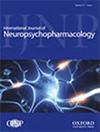Altered serotonin 1B receptor binding after escitalopram for depression is correlated with treatment effect
IF 3.7
2区 医学
Q1 CLINICAL NEUROLOGY
引用次数: 0
Abstract
Background Major depressive disorder (MDD) is commonly treated with selective serotonin reuptake inhibitors (SSRIs). SSRIs inhibit the serotonin transporter (5-HTT) but the downstream antidepressant mechanism of action of these drugs is poorly understood. The serotonin 1B (5-HT1B) receptor is functionally linked to 5-HTT and 5-HT1B receptor binding and 5-HT1B receptor mRNA is reduced in the raphe nuclei after SSRI-administration in primates and rodents respectively. The effect of SSRI treatment on 5-HT1B receptor binding in MDD subjects has not been examined previously. This positron emission tomography (PET) study aimed to quantify brain 5-HT1B receptor binding changes in vivo after SSRI treatment for MDD in relation to treatment effect. Methods Eight unmedicated patients with moderate to severe MDD underwent PET with the 5-HT1B receptor radioligand [11C]AZ10419369 before and after 3-4 weeks of treatment with the SSRI escitalopram 10mg daily. Depression severity was assessed at time of PET and after 6-7 weeks of treatment with the Montgomery-Åsberg Depression Rating Scale (MADRS). Results We observed a significant reduction in [11C]AZ10419369 binding in a dorsal brainstem (DBS) region containing the median and dorsal raphe nuclei after escitalopram treatment (p = 0.036). Change in DBS [11C]AZ10419369 binding correlated with MADRS reduction after three (r = 0.78, p = 0.021) and seven (r = 0.94, p < 0.001) weeks’ treatment. Conclusions Our findings align with the previously reported reduction of 5-HT1B receptor binding in the raphe nuclei after SSRI administration and support future studies testing change in DBS 5-HT1B receptor binding as an SSRI treatment response marker.艾司西酞普兰治疗抑郁症后血清素 1B 受体结合的改变与治疗效果有关
背景重度抑郁症(MDD)通常采用选择性血清素再摄取抑制剂(SSRIs)进行治疗。SSRIs 可抑制血清素转运体(5-HTT),但这类药物的下游抗抑郁作用机制却鲜为人知。5-羟色胺 1B(5-HT1B)受体在功能上与 5-HTT 和 5-HT1B 受体结合相关,灵长类动物和啮齿类动物分别服用 SSRI 后,其剑突核中的 5-HT1B 受体 mRNA 会减少。此前尚未研究过 SSRI 治疗对 MDD 患者 5-HT1B 受体结合的影响。这项正电子发射断层扫描(PET)研究旨在量化 MDD 患者接受 SSRI 治疗后体内大脑 5-HT1B 受体结合的变化与治疗效果的关系。方法 八名未接受治疗的中度至重度 MDD 患者在每天服用 SSRI 依西酞普兰 10 毫克治疗 3-4 周之前和之后接受了 5-HT1B 受体放射性配体 [11C]AZ10419369 的正电子发射断层扫描。在进行 PET 时和治疗 6-7 周后,使用蒙哥马利-阿斯伯格抑郁量表 (MADRS) 评估抑郁严重程度。结果 我们观察到,经艾司西酞普兰治疗后,背侧脑干(DBS)区域的[11C]AZ10419369结合率明显降低(p = 0.036)。治疗三周(r = 0.78,p = 0.021)和七周(r = 0.94,p &p;lt;0.001)后,DBS [11C]AZ10419369 结合力的变化与 MADRS 下降相关。结论 我们的研究结果与之前报道的服用 SSRI 后剑突核 5-HT1B 受体结合率降低的情况一致,并支持未来的研究将测试 DBS 5-HT1B 受体结合率的变化作为 SSRI 治疗反应标记。
本文章由计算机程序翻译,如有差异,请以英文原文为准。
求助全文
约1分钟内获得全文
求助全文
来源期刊
CiteScore
8.40
自引率
2.10%
发文量
230
审稿时长
4-8 weeks
期刊介绍:
The central focus of the journal is on research that advances understanding of existing and new neuropsychopharmacological agents including their mode of action and clinical application or provides insights into the biological basis of psychiatric disorders and thereby advances their pharmacological treatment. Such research may derive from the full spectrum of biological and psychological fields of inquiry encompassing classical and novel techniques in neuropsychopharmacology as well as strategies such as neuroimaging, genetics, psychoneuroendocrinology and neuropsychology.

 求助内容:
求助内容: 应助结果提醒方式:
应助结果提醒方式:


